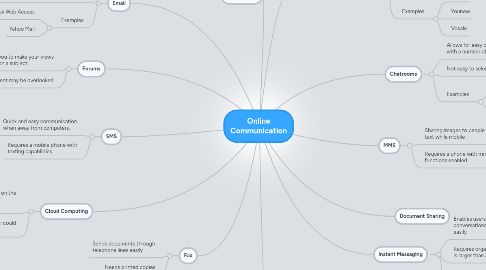Online Communication
by Jake Enfield


1. Conference Calls (VOIP)
1.1. Allows for quick face-to-face conversations with minimum delay
1.2. Some people prefer face-to-face interaction
1.3. Some people will have lag/connection problems
1.3.1. Caused by low bandwidth
1.4. Requires Organisation
1.5. Examples
1.5.1. Skype
1.5.2. Younow
1.5.3. Vokale
2. Instant Messaging
2.1. Enables users to have typed conversations quickly and easily
2.2. Requires organizing if the group is larger than 2
2.3. Examples
2.3.1. MSN
2.3.2. Facebook messenger
3. Email
3.1. Some people check emails infrequently
3.2. Can still send if the recipient is busy
3.3. Examples
3.3.1. Outlook Web Access
3.3.2. Yahoo Mail
4. Fax
4.1. Sends documents through telephone lines easily
4.2. Needs printed copies
5. SMS
5.1. Quick and easy communication when away from computers.
5.2. Requires a mobile phone with texting capabilities
6. MMS
6.1. Sharing images to people via text while mobile
6.2. Requires a phone with mms functions enabled
7. Social Networking
7.1. Easy to use
7.2. Shows all 'friends' (or only specified people)
7.3. Blogs are shown to readers easily
7.4. Privacy is not always 100%
7.5. Examples
7.5.1. Facebook
7.5.2. Twitter
7.5.3. Google Plus
8. E-commerce
9. Forums
9.1. Allows you to make your views known on a subject
9.2. your comment may be overlooked
10. Chatrooms
10.1. Allows for easy converstations with a number of people
10.2. Not easy to select numbers of people
10.3. Examples
10.3.1. Omegle
10.3.2. Chatroulette
